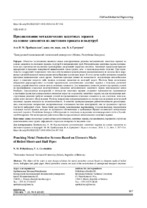| dc.contributor.author | Прибыльская, Н. М. | |
| dc.contributor.author | Гречухин, В. А. | |
| dc.coverage.spatial | Минск | ru |
| dc.date.accessioned | 2024-11-27T09:39:06Z | |
| dc.date.available | 2024-11-27T09:39:06Z | |
| dc.date.issued | 2024 | |
| dc.identifier.citation | Прибыльская, Н. М. Продавливание металлических защитных экранов на основе элементов из листового проката и полутруб = Punching Metal Protective Screens Based on Elements Made of Rolled Sheets and Half Pipes / Н. М. Прибыльская, В. А. Гречухин // Наука и техника. – 2024. – № 6. – С. 507-516. | ru |
| dc.identifier.uri | https://rep.bntu.by/handle/data/150803 | |
| dc.description.abstract | Объектом исследования являются новые конструктивные решения металлических защитных экранов на основе элементов из листового проката, полутруб и направляющих труб. Металлические защитные экраны применяются при строительстве подземных транспортных сооружений закрытым способом. Защитный экран предотвращает деформации и просадки поверхности вышележащих слоев грунта, авто- и железнодорожного полотна. При строительстве сооружений тоннельного типа под действующими транспортными коммуникациями не должны быть нарушены условия безопасной эксплуатации автомобильных и железных дорог. В этом случае особое внимание уделяется просадкам вышележащих слоев грунта. Величина просадок влияет на возможность эксплуатации автомобильных дорог и снижение скорости либо полную остановку движения на железной дороге. Поэтому было исследовано напряженно-деформированное состояние предлагаемых металлических защитных экранов с помощью расчетной модели, разработанной на основе метода конечных элементов. Для повышения точности расчета внутренних усилий на продавливание отдельных конструктивных элементов металлического защитного экрана использовался метод Ромберга. Предлагаемые конструкции и технологии защитных экранов сохраняют преимущества применяемых в настоящее время при одновременном снижении затрат на сооружение защитного экрана, так как исследуемые конструктивные решения требуют меньших усилий на продавливание отдельных элементов и, как следствие, использования менее мощного оборудования. Расчеты напряженно-деформированного состояния предложенных конструкций защитных экранов показали их жизнеспособность. В качестве критерия проверки работоспособности рассматривались максимальные напряжения, воспринимаемые отдельными частями конструкций, они не превышают предела текучести выбранной стали. Также были рассчитаны максимальные вертикальные и горизонтальные перемещения отдельных частей экранов, которые не превышают обозначенных в требованиях Правил технической эксплуатации железной дороги в Республике Беларусь и Инструкции по текущему содержанию железнодорожного пути в Российской Федерации. Это подтверждает работоспособность предлагаемых металлических защитных экранов. | ru |
| dc.language.iso | ru | ru |
| dc.publisher | БНТУ | ru |
| dc.title | Продавливание металлических защитных экранов на основе элементов из листового проката и полутруб | ru |
| dc.title.alternative | Punching Metal Protective Screens Based on Elements Made of Rolled Sheets and Half Pipes | ru |
| dc.type | Article | ru |
| dc.identifier.doi | 10.21122/2227-1031-2024-23-6-507-516 | |
| local.description.annotation | The object of the study is new design solutions for metal protective screens based on elements made of rolled
sheets, half-pipes and guide pipes. Metal protective screens are used in the construction of underground transport structures using a closed method. The protective screen prevents deformations and subsidence of the surface of overlying soil layers, road and railway bed. During the construction of tunnel-type structures under existing transport communications, the conditions for the safe operation of roads and railways must not be violated. In this case, special attention is paid to subsidence of the overlying soil layers. The magnitude of subsidence affects the possibility to operate roads and reduce the speed or completely stop traffic on the railway. Therefore, the stress-strain state of the proposed metal protective screens was studied using a calculation model developed on the basis of the finite element method. To improve the accuracy of calculating internal forces on punching individual structural elements of a metal protective screen, the Romberg method was used. The proposed designs and technologies of protective screens retain the advantages of those currently used, while simultaneously reducing the costs of constructing a protective screen, since the design solutions under study require less effort to push through individual elements, and, as a consequence, use less powerful equipment. Calculations of the stress-strain state of the proposed designs of protective screens have shown their viability. As a criterion for checking the operability, the maximum stresses perceived by individual parts of the structures were considered; they do not exceed the yield strength of the selected steel, and the maximum vertical and horizontal displacements of individual parts of the screens were calculated, which do not exceed those specified in the requirements of the Rules for Technical Operation of Railways in the Republic of Belarus and the Instructions for Current Maintenance of Railway Tracks in the Russian Federation. This confirms the operability of the proposed metal protective screens. | ru |

